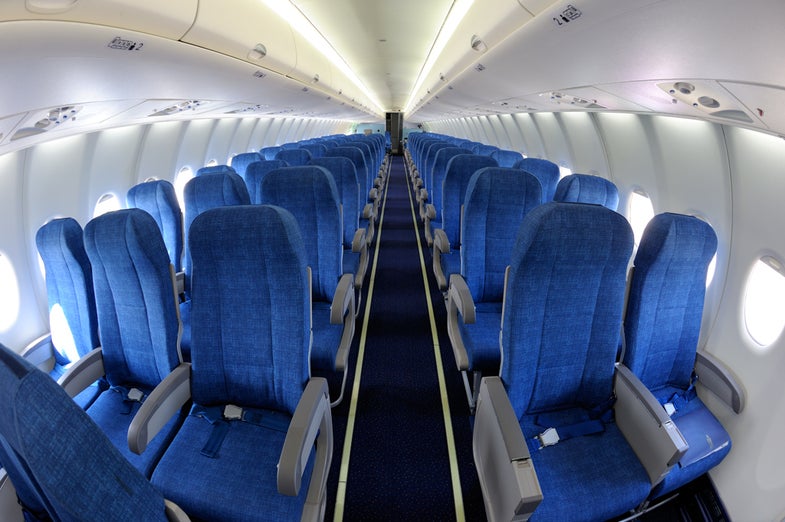How Sneeze Particles Travel Inside An Airplane
Simulation technology shows why you should sit very far behind a sick passenger.

At first, the video displays the virtual insides of a crowded passenger airplane. Then all of a sudden, one of the passengers seated in the middle “sneezes.” Hundreds of multicolored particles are jettisoned into the air, creating a rainbow-speckled cloud that lingers above everyone’s heads. The cloud dissolves, and the particles disperse, making their way to the unlucky few seated adjacent to the sick passenger.
By the end, the particles have spread all over the cabin, but it’s the people seated to the left and to the right of the “sneezer” who are at the highest risk of infection.
This simulation video reveals just one of the many ways influenza particles can travel in a pressurized airplane cabin. Modeling these high-flying infectious scenarios is the job of ANSYS, a company that specializes in precise simulation software. ANSYS uses computational fluid dynamics to simulate the pattern of airflow in airplanes in order to help airlines and health officials trace how flu particles are distributed at 39,000 feet. You can watch a video of their simulation below:
“The particles are colored to show you where the stuff goes,” Robert Harwood, aerospace and defense industry director for ANSYS, explains to Popular Science. “Those droplets get picked up by the airflow and get transplanted all over the cabin. They actually spread quite far.”
Although the spread of Ebola may be on everyone’s minds, it’s important to remember that Ebola is not an airborne pathogen. You can’t catch it if someone sneezes on an airplane. The flu, however, does spread through the air, and it poses a much more substantial threat in the United States, affecting tens of millions of Americans each year and causing up to 49,000 deaths, according to the Centers for Disease Control and Prevention.
“Those droplets get picked up by the airflow and get transplanted all over the cabin. They actually spread quite far.”
Since flu shots don’t provide 100 percent protection, health officials are always looking for ways to cut down on the virus’s spread. To do that, they often turn to airplanes — one of the most efficient modes of travel for pathogens. Filled with hundreds of passengers, squished in and unable to escape, airplane cabins can be the perfect breeding ground for the flu; all you need is one sick passenger to get things started.
Figuring out how flu particles spread on airplanes has been a concern of the Federal Aviation Administration since the outbreak of SARS in 2002. “There were outbreaks all over the world, in Asia, Africa, and Europe,” says Harwood. “The reason it happened so quickly was because people got on airplanes and spread the pathogen.”
After the SARS outbreak, the FAA formed the Centers for Excellence for Airliner Cabin Environment Research to ensure the safety and health of airplane occupants. The program tested a number of new technologies for pathogen tracking, including new cabin sensor systems and contamination mitigation technology. And that’s when ANSYS’s simulation technology stepped into the realm of aviation.
“With traditional engineering, you come up with an idea, build a model or prototype, test it, and modify it until you get the product you want,” says Harwood. “The business we’re in, before you cut metal, you use computers to simulate the physical behavior of that product to cut down on modifications.”
ANSYS normally develops simulation software for engineering, physics, structural mechanics, elastics, fragmentation, and more. Their technology can tell you if the handle in your coffee cup is going to be strong enough, or if an airplane wing will have optimum lift and drag in the air. However, the company also has the ability to model the aerodynamics of fluids, making their software ideal for mapping the spread of flu in a contained space. So for years, scientists at the FAA’s Center of Excellence at Purdue University have studied ANSYS simulations, learning more about the mechanics of pathogen travel in pressurized cabins.
Within airplanes, the air is constantly being pumped in from inlets in the ceiling and recycled out through vents at the passengers’ feet, making airflow models quite complicated to create. “Every two minutes, there’s a whole new set of air in the aircraft,” Harwood says. To make their airflow simulations as realistic as possible, the researchers at Purdue consider everything that might impact the velocity and direction of the flow of air, from the positioning of the overhead air conditioning nozzles to the currents created by flight attendants as they push the food and drink carts.
Considering all these variables, the scientists can create hundreds of scenarios for how germs and other contaminants spread within an airplane. Then they use what they’ve learned to make recommendations to the FAA for creating better – and safer – cabin areas. “Since this work really started, you’ve got more advanced passenger environments,” Harwood says. “It’s a key protective battleground against the flu and other germs.”
ANSYS’s software also helps airlines improve their cabin environments on the cheap. By simulating how new air conditioning systems will affect airflow, airlines can figure out which systems reduce germ travel for the lowest cost.
“Airlines are constantly fighting this trade off: The more systems you put in the aircraft, the more weight you have and the more money it costs,” says Harwood. “They want the cheapest flight but also for their passengers to be healthy. Our technology is useful because they can see how they can achieve that and improve performance without sacrificing cost.”

H1N1 Flu